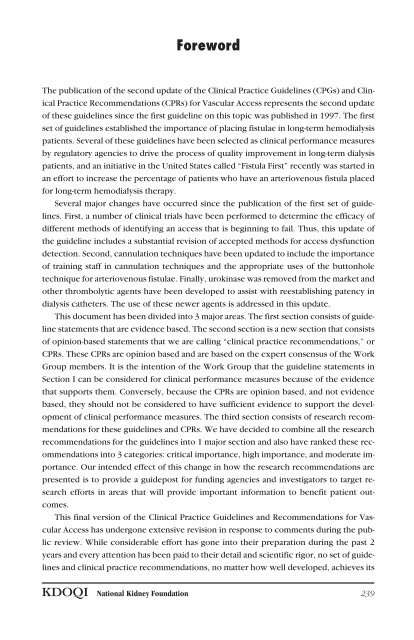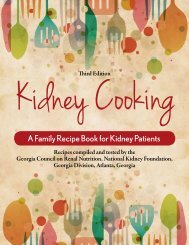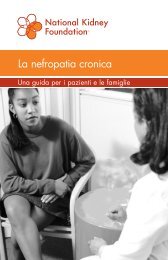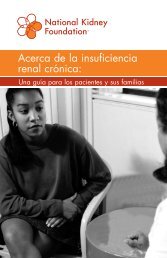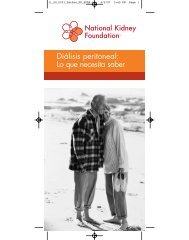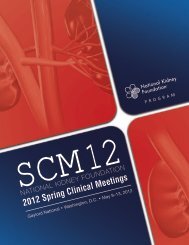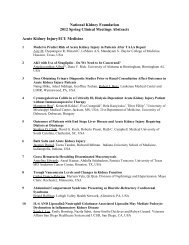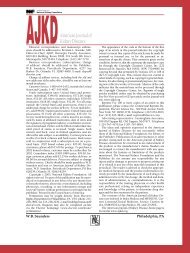2006 Updates Clinical Practice Guidelines and Recommendations
2006 Updates Clinical Practice Guidelines and Recommendations
2006 Updates Clinical Practice Guidelines and Recommendations
You also want an ePaper? Increase the reach of your titles
YUMPU automatically turns print PDFs into web optimized ePapers that Google loves.
Foreword<br />
The publication of the second update of the <strong>Clinical</strong> <strong>Practice</strong> <strong>Guidelines</strong> (CPGs) <strong>and</strong> <strong>Clinical</strong><br />
<strong>Practice</strong> <strong>Recommendations</strong> (CPRs) for Vascular Access represents the second update<br />
of these guidelines since the first guideline on this topic was published in 1997. The first<br />
set of guidelines established the importance of placing fistulae in long-term hemodialysis<br />
patients. Several of these guidelines have been selected as clinical performance measures<br />
by regulatory agencies to drive the process of quality improvement in long-term dialysis<br />
patients, <strong>and</strong> an initiative in the United States called “Fistula First” recently was started in<br />
an effort to increase the percentage of patients who have an arteriovenous fistula placed<br />
for long-term hemodialysis therapy.<br />
Several major changes have occurred since the publication of the first set of guidelines.<br />
First, a number of clinical trials have been performed to determine the efficacy of<br />
different methods of identifying an access that is beginning to fail. Thus, this update of<br />
the guideline includes a substantial revision of accepted methods for access dysfunction<br />
detection. Second, cannulation techniques have been updated to include the importance<br />
of training staff in cannulation techniques <strong>and</strong> the appropriate uses of the buttonhole<br />
technique for arteriovenous fistulae. Finally, urokinase was removed from the market <strong>and</strong><br />
other thrombolytic agents have been developed to assist with reestablishing patency in<br />
dialysis catheters. The use of these newer agents is addressed in this update.<br />
This document has been divided into 3 major areas. The first section consists of guideline<br />
statements that are evidence based. The second section is a new section that consists<br />
of opinion-based statements that we are calling “clinical practice recommendations,” or<br />
CPRs. These CPRs are opinion based <strong>and</strong> are based on the expert consensus of the Work<br />
Group members. It is the intention of the Work Group that the guideline statements in<br />
Section I can be considered for clinical performance measures because of the evidence<br />
that supports them. Conversely, because the CPRs are opinion based, <strong>and</strong> not evidence<br />
based, they should not be considered to have sufficient evidence to support the development<br />
of clinical performance measures. The third section consists of research recommendations<br />
for these guidelines <strong>and</strong> CPRs. We have decided to combine all the research<br />
recommendations for the guidelines into 1 major section <strong>and</strong> also have ranked these recommendations<br />
into 3 categories: critical importance, high importance, <strong>and</strong> moderate importance.<br />
Our intended effect of this change in how the research recommendations are<br />
presented is to provide a guidepost for funding agencies <strong>and</strong> investigators to target research<br />
efforts in areas that will provide important information to benefit patient outcomes.<br />
This final version of the <strong>Clinical</strong> <strong>Practice</strong> <strong>Guidelines</strong> <strong>and</strong> <strong>Recommendations</strong> for Vascular<br />
Access has undergone extensive revision in response to comments during the public<br />
review. While considerable effort has gone into their preparation during the past 2<br />
years <strong>and</strong> every attention has been paid to their detail <strong>and</strong> scientific rigor, no set of guidelines<br />
<strong>and</strong> clinical practice recommendations, no matter how well developed, achieves its<br />
KDOQI National Kidney Foundation 239


